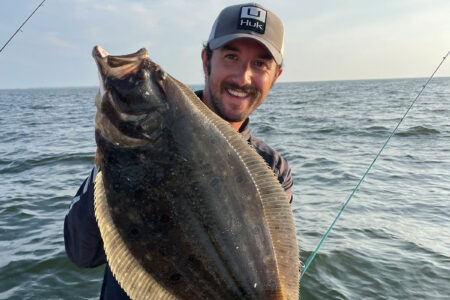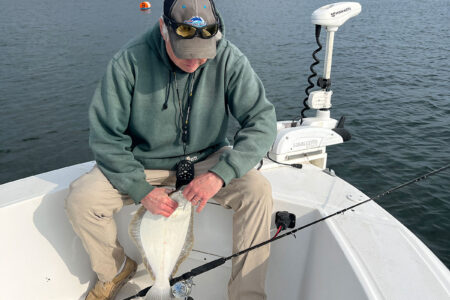
Nantucket Shoals get all the press, here are some hot zones you may have forgotten about!
Every fluke fisherman dreams of one day connecting with a trophy-sized fish, that ‘doormat of dreams’ that haunts us through the long winter months. Summer flounder, commonly called fluke, have extensive ranges along the Northeast coast, being found anywhere from the uppermost reaches of bays and estuaries, to deep-water wrecks and ledges in 30 fathoms and beyond. As the record books show, double-digit fluke have been caught in all of those places, as well as some unexpected ones.
Over the last few years, one area that has captured the attention of trophy fluke hunters from up and down the East Coast are the deep-water rips of Nantucket Shoals. And for good reason – this vast expanse of mostly sandy bottom looks like a washboard from space. The many humps, ridges, trenches and drop-offs south of the island collect and hold lots of bait during the early summer, particularly huge schools of squid. And the doormat fluke are certainly there.
Although, with increased attention and fishing pressure during the last few years, Nantucket Shoals – according to charter captains who fish there every day – just ain’t what it used to be in terms of an almost-guaranteed trophy fluke. Also, it’s relatively far offshore, and often plagued by dense fog, so it might be time to revisit some of the other fluke spots in our area that maybe haven’t seen the recent glory of Nantucket Shoals, but have produced truly giant fluke over the decades.
Noman’s Island
Just southwest of Martha’s Vineyard, Noman’s Island remains off-limits to people going ashore (thanks to unexploded ordinance from its days as a Navy bombing target), but it’s surrounded by amazing structure that holds big fish. Noman’s might be better known as a classic spot for big stripers, bluefish and bonito, but the same environmental factors that attract those gamefish also make it a hotspot for doormats.
The Massachusetts state record fluke (an eye-popping 21.5 pounds) came from these waters, and the rocky structure of Southwest Shoal could yield even bigger fish. Here, the ledge rises to 60 to 70 feet up from 100-plus, and because of scattered boulders the area often escapes pressure from draggers. Pay attention to where you see lobster or fish pots, as those guys have the area pretty dialed in, and know where much of best bottom is. There are also huge black sea bass out there to add to the mix, and the usual methods of jigs and teasers or 3-way fluke rigs should get the job done.
I prefer big baits in the waters around Noman’s (maybe because I keep picturing that State Record fish) but long strips of squid or fish belly with appropriate amounts of lead will keep your trophy-sized bait down in the doormat zone. I’ve also done well off the north side of the island, between Noman’s and Gay Head or Cuttyhunk, making long drifts on a western tide where the bottom goes from 60 to 90 feet, and if I’m making subtle adjustments to avoid lobster and fish pot buoys, I know I’m in the right zone.

Around Vineyard Sound
Next, don’t forget about the deep holes and trenches found in the western end of Vineyard Sound. Reaching depths of 90 to 110 feet and with a variety of bottom structure, these inshore canyons have long held numbers of trophy fluke. One August afternoon a few years back, two friends and I caught seven fish over 10 pounds – the biggest pushing 14 – while using strip baits rigged on a dropper off an 8-ounce chrome “fluke bomb”. That day, fishing depths better than 100 feet only a short distance off the shore, we also caught some massive black sea bass, a 38-inch striper and even a 9-pound weakfish!
There can be frustrating times where dogfish are thick, or scup and sea robins harassing your baits, but often a quick move to a deeper or shallower spot can put you back in the fluke game. Some of the shallower structure in the Sound, like Lucas Shoal, gets a fair amount of fluke pressure and can give up great numbers of fish, in my experience the doormats lie in deeper water during the summer. That August day we were making long drifts in some of the deep trenches along the south side of the Elizabeth Islands, where the bottom constantly rises and falls with series of humps and holes. Because of such an up-and-down bottom along these stretches, long drifts work well with anglers who are able to actively follow the bottom.
That said, one May afternoon a friend and I were drifting south of Robinson’s Hole along the deep trench there, and after catching some nice keepers, we decided to break for lunch. My friend, Captain John Lee of JL Charters in Point Judith, was tasked with making the sandwiches, so he put a fresh extra-long squid strip on his 6-ounce white Spro jig, dropped it to the bottom, shrugged his shoulders, put the rod in the holder and started spreading mayonnaise on bread. Not two minutes later the rod bucked over and he was rewarded with the best fish of the day, a 13.5-pounder that barely fit in the net.
There’s a lot of overlooked and interesting water around that part of the Sound, and the more you explore, the better your chances of finding something untouched. Again, study bottom charts, maybe turn on the depth shading feature on your plotter, and find those deep holes.
South of Sakonnet
The area between Sakonnet Point and Brown Ledge has long been an excellent spot to connect with a trophy doormat. The western tides flush bait out of Vineyard Sound and Buzzard’s Bay, bringing easy food to ambush predators like fluke. The bottom has a lot of variety – hard sand, mixed cobble, mussel beds and boulder fields – and oftentimes the most productive fishing spots are where the bottom composition changes from one type to another. Also, the deep channels formed by thousands of years of strong tides can often hold cooler water during the hot summer months, attracting schools of squid, and the fluke that devour them, close by throughout the season.
A good starting place is the area right around the Buzzard’s Bay Tower, and long drifts are also possible here, as long as anglers adjust to the changing depths beneath them as the drift progresses. This area gets a fair amount of blackfish pressure, especially in the fall, but those looking for doormats should ignore the high spots and reefs and concentrate on the deep trenches between them. There are some really deep spots in this area I want to explore further, even if it requires bank sinkers that would be more at home on a tuna rig. On a strong tide, I’ve often had to go to 12 to 16 ounces of lead just to hold my baits in the zone. Pay close attention to your sounder, and many MFD units now have features that can pinpoint the bottom composition under your boat – find the changes and you’ll find the fish.
Off Block
You can’t talk about big fluke without mentioning Block Island. Rhode Island boats put up consistent numbers of jumbo flatties in the waters surrounding Block, and again, the variety of bottom seems to be a key. Patches of hard sand abut areas of cobble bottom, with those transition zones often holding the most fluke. Another option is to do shorter drifts around the many rock piles and boulder clumps in the 50- to 70-foot range, where you may get fewer bites but the fish tend to be larger.
There are often huge schools of sand eels around Block, along with squid, butterfish and other essential bait to attract and hold gamefish. Bearing the prevalent bait in mind, try and match the hatch to what fluke are keyed in on. I always though it seemed crazy to add a sand eel or spearing to an already-juicy strip bait, but the numbers don’t lie. The East Grounds can also be excellent for big fluke, and provides long drifts over varied bottom and has long been a favorite of the best charter guys. The striped bass fishing at Southwest Ledge is legendary, and for good reason as it has amazing structure, close access to deep water and strong tides – all reasons why it’s also a perennial big fluke spot.
The tides south of the island seems to run towards the west with strange frequency, but that can provide long, active drifts over great bottom. The bass often take the spotlight at Block, but the same ingredients that bring them there in such numbers also provide the perfect setup for slammer fluke – and maybe a bonus cod!

Overlooked Inlets
Finally, there always remains another great option that’s available to smaller boats, even kayak fishermen looking to connect with a trophy fluke. Our New England coast has countless inlets and harbor entrances, where bait-filled bays and estuaries empty out through deep channels. These are perfect places to lighten up the tackle and employ a simple bucktail-and-trailer rig, even on spinning tackle. Often, you can get away with 2- or 3-ounce jigs in these areas, making the fishing a lot more fun, and maybe even more effective with a more natural presentation.
And a kayak might very well be the best kind of vessel for exploring these inlets, being able to fish close to the jetties but still having range to probe outside of the inlet. Remember, the surrounding area of an inlet is still a magnet for predators, and they will shift their positions depending on the changes of tide and flow. Although outgoing (or dropping) tides usually provide the best action, an incoming tide can also produce, as the bait that flushes out will quickly try and get back to its shallow water sanctuary and school up tightly at the inlet entrance.
Even jetty anglers can get in on the action, casting jigs well uptide, letting them sink then hopping the lure back in that last quarter of the swing. Harbors and estuaries are bait factories, and big fluke know that, staging up and using the current above them to ambush bait. On that note, the slack tides are probably better spent casting for other species, as one thing fluke require to really chew is a good, strong flow above them.
Old School Ideals
When I hear about the sometimes-epic fluke fishing at Nantucket Shoals, I can’t help but wonder how many trophy doormats those anglers passed by on their long trips by car and boat. Fluke don’t read magazines or the internet, and although the latest-and-greatest fishing fads drive us crazy, the fish usually do the same things they always have. I’ve caught plenty of fish on crazy-colored ultra-scented plastic baits, but I often find myself reaching for what has worked for decades, so I usually use long squid or belly strips on my jigs and rigs.
Many, many giant fluke were caught before terms like Nuclear Chicken or Pink Shine ever entered our vocabulary. And by the same logic, I think the attention and pressure on Nantucket Shoals has left fluke fishermen some great opportunities for connecting with the fish of their dreams, hopefully with shorter steams and smaller crowds. There remains some incredible, and recently overlooked places to connect with doormats, and a bit of homework ahead of time will help put you in the game. Stare at nautical charts whenever you can, because once you figure out the types of bottom structure, bottom changes and water flow big doormats prefer, your chances of fulfilling those dreams go up bigtime. Nantucket Shoals may have gotten all the attention in the fluke world these past few years, but let’s make that change with some trophy doormat catches closer to home.



